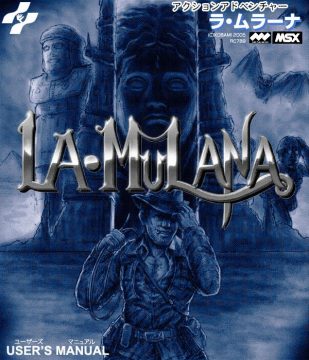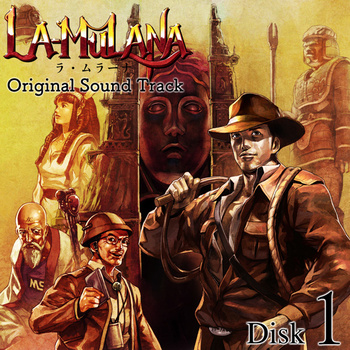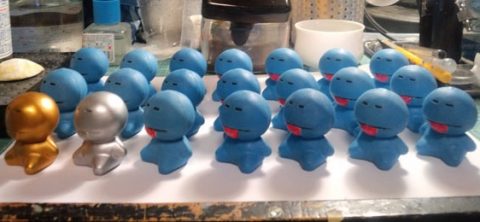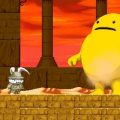- La-Mulana
- La-Mulana 2
“My work is a thing to kill the player.” – Takumi Naramura
You can find Naramura, the designer of La-Mulana, in a few places in his game: in an easter egg Developer Room, and as a hidden boss. He chooses to represent himself as a vaguely humanoid blue figure with closed, indifferent eyes and a protruding pink tongue. Naramura’s avatar is exactly what you would expect to be behind this game: wagging his mocking tongue all the while, he offers no sympathy as you fall prey to yet another one of his traps.
La-Mulana, a modern love-letter to old-school Japanese adventure games for the MSX computer, gleefully recalls the most brutally difficult aspects of that era of gaming. The Japanese indie developer GR3 PROJECT released La-Mulana as PC freeware in 2005. In 2011, under the new company name Nigoro, they released an enhanced remake for WiiWare and PC. Among those willing to brave its challenges, La-Mulana earned a dedicated following for its retro-style approach, the depth of its world, and capturing a feeling of true exploration. The often Engrish-filled digital manual has some insight into its design philosophy:
“La-Mulana is a game that was designed to remind those gamers tired of the ‘super graphics, easy gameplay’ types of game commonplace on modern consoles just how fun the old style of games can really be. … For those used to the new-style of really easy games, it may be very hard to beat La-Mulana. But that’s OK.”
La-Mulana does not delay the presentation of its difficulty. You play as Lemeza Kosugi, a Japanese-American professor wielding a whip and an MSX laptop (both equally crucial to his quest; collectible ROMs for the computer help decode ancient writing and display maps, among other functions), as he arrives at a village above the ruins of La-Mulana, the site of a great treasure. He can walk, crack his whip, and jump, but not much more – in the initial village section, a general feeling of futility sets in as you find unreadable stone tablets, an unreachable entrance to the ruins, and in an affront to all self-preservative gaming instincts, no way to save your game. To enter the ruins, you must first complete a simple puzzle; to read tablets and save, you must first buy the appropriate Hand Scanner and Game Master ROM items from a village shop with coins earned from killing enemies. If there’s no hand-holding at the very beginning, there is no reason to expect any later.
The 8-bit graphics and sound are simple and styled on similar MSX games, such as Maze of Gallious and King’s Valley, but stand well enough on their own if you haven’t played the games which inspired it. The limited color palette sometimes leads to some difficult situations where enemies blend into certain parts of the background – bats are always a liability in screens with water. Luckily, the green of Lemeza’s clothes is rare enough in the game’s backgrounds that it’s easy to keep an eye on him. The bosses look particularly spectacular – from the one-eyed giant Viy who chases Lemeza relentlessly upward through a tunnel, harassing him with tentacles and lasers, to the Mayan Astronaut-inspired alien Palenque, whom Lemeza must battle from a miniature plane in a genre-bending scrolling shooter section. They are not often animated, but they are huge and detailed nonetheless. The game’s soundtrack is top-notch and energetic, though in difficult areas like the Gate of Illusion or the Twin Labyrinths, the music captures an appropriate mood of despair too well, and might not be welcome in your ears after hours of stumbling around hopelessly.
Nigoro classifies La-Mulana as a “Ruins Exploration Archaeological action game,” which at first seems to be a stumbling approximation of what is usually meant by “Metroidvania,” but the archaeological aspects are essential to the atmosphere and style of play in La-Mulana. The immense titular ruins are divided into nine sections, each with a corresponding “Fronside” and “Backside” field. The Frontside usually presents one theme which is subverted by the backside; the first field, the Gate of Guidance, serves to familiarize you with the game’s logic and expectations, but its corresponding Backside, the Gate of Illusion, serves to break your trust and confound you with invisible ladders, warp points, and a general sense of malevolence.
The general rhythm of progress through the ruins involves solving puzzles, finding new items or equipment, defeating one of the eight Guardians, or simply exploring new areas. Each kind of achievement leads to others, though not always in a clear way. The manual reminds players “you are an ‘Archaeologist.’ Pay attention to small change and strange place in the Ruins!” A chime alerts you when you’ve solved a puzzle, but the solution’s effects may manifest themselves anywhere in the ruins, regardless of the distance. One of the frustrating parts of La-Mulana is accidentally stumbling upon this puzzle-solved chime, not knowing what you’ve done to earn it or what effects it will have on the ruins.
One mark of progress through the ruins is collecting items, which range from essential movement upgrades (the Feather, which grants a second jump) to protective equipment (the Ice Cape, which allows Lemeza to swim in lava), to new weapons (the Flare Gun, which fires directly upward). The most important and sanity-saving item, nothing less than the Holy Grail itself, lets you teleport to any Grail Tablet you have found, one which can be found in each field, by opening the MSX computer and pressing buttons 0-9, each button corresponding to a Frontside field. The Grail can access Backside fields as well, through an obscure combination of equipped ROMs. Of course, the same frustration can come with finding items that comes with solving puzzles; since finding a new item only tells you its name, it’s not always clear what an item does, and satisfaction can quickly turn into disappointment when, hoping for a merciful Life Jewel which could extend your life bar, you acquire some Pepper without a clear immediate use.
One of the game’s greatest successes is in the cautious style of exploration it cultivates in the player. Since Lemeza begins the adventure so weak, and since traps are so frequent, death is never at a safe enough distance. There are a few mechanics which quickly discourage well-ingrained but reckless habits of game exploration: Eyes of Truth in the background warn you that certain chests and walls are under divine protection, and will strike Lemeza with lightning if he attacks them, so you can’t strike everything in sight searching for hidden corridors; deep mine shafts generally end in spikes, so you shouldn’t jump down blindly; and weight pedestals, often the site of a solution to some puzzle, just as often trigger a trap if the player has no justification to trigger the pedestal. The end result is an atmosphere of constant danger, but one in which every death is fair and the result of your own actions.
Unlike most games within the genre, a large portion of La-Mulana‘s fields are open to the player from the outset, but many will prove too difficult at first. Many puzzles in earlier areas prove to be crucial to progress in later fields, so the ruins can be cleared on a field-by-field basis or by exploring a bit here, then a bit there. As a result of this openness, you get a feeling of where to go not from an explicit direction of the game, but through diving head-first into various areas and seeing which ones hold the most merciful deaths for Lemeza.
Not to say that La-Mulana provides no direction – the directions that it does provide are one of the game’s strongest and most unique features. Throughout the fields, there are scattered various tablets written in an ancient language which flesh out the particular backstory of each field and its inhabitants. These writings range from the last words of a nearby skeleton, which warn the player to a nearby trap, to an obscure verse of poetry, which proves to be essential in solving a nearby (or, all too often, distant) puzzle.
Take for example an early field, Mausoleum of the Giants. There is a series of tablets throughout the field which tell the story of a race of giants:
“We are the second race born of the Great Mother. We were born to return her to the skies. This is the sad story of our race. Nine brothers led our race: Zeb, Bud, Migera, Led, Fut, Abt, Zi, Riv, and Sakit.”
Statues of these nine giants stand throughout the field, posed in various ways, acting out the roles described for them in the tablets. The giants split into two factions, one seeking to return the Mother to the sky, the other trying to keep the Mother on the earth. Tablets later in the game will reveal the ruins of La-Mulana to be the body of the Mother, the creator of all life. You can see why the giants had a hard time returning her to the sky.
“The sun shone brightly the day Ledo fell in battle. A gaping hole in his chest, he entered his eternal slumber.”
At the heart of the Mausoleum is a group of three pedestals, together bearing some combination of suns, moons, or stars. Whipping a pedestal changes the sign displayed on all three pedestals, in a definite pattern but not an obvious one – like rotating a Rubik’s Cube while only able to see one face. When all three pedestals have one sign, the giants change position according to what is said in the tablets – in Ledo’s puzzle, for example, setting the three pedestals to Sun gives the statue of Ledo a hole in his chest, which has significance in another tablet:
“The youngest, Sakit, tread his own path. He put a key on Ledo’s body, falling into slumber with his powers in hand.”
Naturally, there is a “key” of sorts, or something at least as useful, hidden in Ledo’s chest, which opens the way to battle with Sakit, also the area’s Guardian. The fields of La-Mulana are generally organized in this way, the puzzles related to a central narrative revealed through tablets, but the Mausoleum of the Giants is probably the best execution of this idea. Since the field appears early in the game, and the player depends so heavily on the tablets to solve the central puzzle, the game provides a strong incentive early on to keep some kind of record of the tablets seen so far, whether by taking screenshots or by keeping an old-fashioned journal. The Mausoleum is thus a smaller representation of the rest of the ruins – piecing together clues from the tablets is essential to solving the larger mysteries throughout the ruins.
Of course, the obscurity of some of the puzzles can be a difficult hurdle, and what one player sees as “staying true to old-school roots” may just as easily be “needlessly frustrating” to another. Beyond the tablets, there are a few sometimes-reliable sources of hints in the forms of Elder Xelpud, who is equally likely to wax poetic about the virtues of various MSX games as he is to offer specific puzzle hints, and in the last words of skeletons, who died in various stages of puzzle completion but obviously never made it all the way through.
One puzzle infamous among players for its obscurity is the “dance of life,” which involves two distant tablets in mid-game fields, one simply an engraving of a figure whipping and jumping in a sequence and another tablet saying “Dance here. Praise life.” Lemeza must perform the sequence of attacks and jumps described in the first tablet in front of this other tablet, never mind the several hours that separate these two tablets. Another puzzle crucial to defeating a late-game boss involves several distant tablets:
The left eye sees Kindness.
The right eye sees Charity.
Charity, Kindness, Charity, Charity, Kindness, Charity, Kindness, Kindness, the endless sound of the waves.
When confronted with a boss consisting of two eyes, fought in a watery arena, Lemeza must attack the eyes in this given order (right, left, right, right, etc.) or the boss will remain invincible. It is impossible to proceed without knowing what was written on those specific tablets; even when the end of the game is in sight, you might still have to do some backtracking and read what you have missed.
In the unlikely event that you would want an even greater challenge, the secret, optional Hell Temple is a sadistic fusion of the game’s most precise platforming, most obscure puzzles, and most difficult combat. There are rooms full of false floors, complex block puzzles, long strings of wall-jumping, and puzzles requiring significant backtracking and mastery of the game’s most peripheral features; through certain ROM combinations, you can access a few minigames, one an homage to Parodius and another a dating sim which abruptly transitions into a Snatcher-inspired shooting gallery sequence. One puzzle in the Hell Temple requires earning a high score in the Parodius clone. The Hell Temple is the culmination of Nigoro’s efforts: it tests all the player’s skills, not just limited to their mastery of La-Mulana‘s physics and lore, but also their mastery of classic games of all sorts.
An official editor was also released for La-Mulana, though it does not seem to have much of a modding community; the text-heavy tool has not been translated into English, which Nigoro feels is the language spoken by the majority of potential modders. Nigoro released two mods along with the editor: a boss rush and a time-attack of the Hell Temple.
In all, La-Mulana is a wonderful example of a game world which truly feels alive – each field is not just a linear series of challenges for the player, but a thriving area where one of the game’s races was born, and has left a legacy for you to discover. Imagine Super Metroid, but one in which you can read about the lives and fates of the Chozo; imagine Castlevania: Symphony of the Night where you can battle your way through Dracula’s kitchen and find his preferred recipe for chocolate chip cookies. It’s not for the faint of heart, but those willing to approach La-Mulana with the careful eye of an archaeologist and the courage of a classic gamer will find its rewards run deep.
Links:
Aeon Genesis – game download and English patch.
La-Mulana Wiki – unofficial but helpful guide.
La-Mulana (ラ・ムラーナ) – Windows, WiiWare, Vita (2011)
After achieving success with La-Mulana, Nigoro rebuilt the game engine from scratch with the intent to appeal to a wider audience while maintaining the original difficulty. After a turbulent development process beginning in 2007, at first failing to earn Nintendo’s approval and thereby being dropped by potential publisher Nicalis, La-Mulana was released commercially on WiiWare in Japan in 2011, then worldwide on both PC and WiiWare in 2012, and later to the PlayStation Vita.
Rather than attempt to wrestle for the rights to every MSX game explicitly mentioned or casually referenced in the original game, Nigoro removed all references to the MSX in remake. Instead of collecting ROMs named after famous games for his MSX, Lemeza collects programs often named after Nigoro’s previous games (“lamulana.exe”) for his Mobile Super X. There are also significantly fewer programs than ROMs, but now most of the programs serve some function beyond filling up blank spaces in Lemeza’s inventory. You can now equip many programs at once – rather than need to juggle the Glyph Reader in and out of Lemeza’s MSX slots whenever you needed to read something, you can keep glyphreader.exe installed as long as you do not exceed the maximum allowed RAM, which is rarely a problem.
However, the most apparent sign of severing the ties to MSX is the updated graphics and sound. The graphics are now fluid and detailed, resembling 2D 32-bit games like Symphony of the Night, and the music is now orchestrated. The expanded color palette makes it easier to distinguish enemies from the background, eliminating the invisible-swimming-bats problem from the original, and a subtle spotlight now shines on Lemeza to keep him in focus. Since the background can now be animated without veiling what is going on in front of it, many dungeons are now much more fleshed out thematically. The Tower of Ruin, previously a tower with vague electrical apparatus in the background, is here a giant engine of cogs and pistons, some of which are now a danger to Lemeza. The music, received the mixed reactions that usually accompany the “updating” of a chiptune-based soundtrack; the compositions are still spot-on, with a few interesting changes here and there, but because they lack the roughness of the instruments, they sound a little blander.
This stylistic change is a mixed blessing – in updating the visuals, the game has lost part of the original game’s distinctive old-school feel, but it has gained more of a footing as an independent game distinct from the old-school games that inspired it. Halfway through the development of the original La-Mulana, its developers derided it as a mere “Maze of Gallious rip-off,” and scrambled to create something more original. Updating the graphics and music are another step toward differentiating La-Mulana from the games which inspired it, but you’d still never forget you were playing a classic-inspired game.
Nigoro said the difficulty was “decreased,” but what happened was closer to a shift of difficulty away from obscurity. Puzzles are a little clearer and better-explicated this time around – tablets are more forthcoming with information, and two characters offer optional hints, should the player need them. Some of the most obscure puzzles were replaced or simplified dramatically – the invisible Rubik’s Cube of star/sun/moon pedestals in the Mausoleum of the Giants was replaced with a simple wheel rotated with switches, and the Charity/Kindness phase of the final boss was replaced entirely. Teleportation with the Grail is much easier, too, now that it is given its own space in the pause menu, with a wheel of icons representing each field. The addition of a third equipment slot for miscellaneous items simplifies reading with the Hand Scanner as well, since you don’t have to switch out of Lemeza’s sub-weapon just to read a tablet. Ultimately, these changes move the remake away from some of the more obscure, inconvenient parts of the original.
However, decreasing the game’s obscurity gave Nigoro a reason to increase the difficulty of the rest of the game. Enemies are more threatening, there are more death-traps, and mini-bosses now present a significant threat. Earlier fields do not ever become totally safe, even with all the upgrades; spikes now deal damage in proportion to Lemeza’s maximum health, and the Ice Cape, rather than rendering lava as inert as water, only decreases the damage it deals over time. These changes help the ruins retain their danger in the late game, which is a good thing – you should feel invincible not just because you have the best armor, but because you are knowledgeable enough to avoid the sources of damage.
The bosses are unquestionably more spectacular this time around, as well. Each boss has a surprise in store for those used to fighting them in the last game – upon reaching a certain threshold of health, they tend to adopt new tactics. Sakit, the giant guardian of the Mausoleum, sheds his face to reveal an iron skull, and can fire his flaming fists at Lemeza like rockets. Some have been completely reworked to make use of new technology, like the fish Bahamut, whom Lemeza now fights in a pseudo-3D waterway. Bosses like Baphomet and Tiamat, who were previously just static sprites, are now animated and terrifying, the latter taking up the entire screen and assaulting Lemeza from the safety of the background.
Included with the PC version, and available on WiiWare as DLC, are a Time Attack boss-rush mode and a revamped Hell Temple, even harder this time around. Nigoro also intended for the PC version to be moddable, at least with respect to the music, graphics, and text, each of these laid out nicely in the game’s directory. The mods available so far, much like the “mods” for the original, are not particularly mindblowing – one replaces the new music with the old chiptune equivalents, and another one undoes the censorship done to the Tower of the Goddess’ nude statues. The moddability of La-Mulana’s remake is better-publicized, yet less powerful, than that of the original, which had a (regrettably still just Japanese) full game editor.
The two versions of La-Mulana are two similar variations on the same idea of capturing the atmosphere and challenge of classic games through an experience of authentic, careful exploration. In short, the original is more difficult with respect to the obscurity of puzzles, and the remake is more difficult in the conventional sense of platforming and combat, but to complete either one is a feat requiring mastery of the game’s physics and lore. The remake provides a more streamlined experience, and eliminates a lot of the inventory-fiddling necessary for basic travel in the original. Many of the changes came from Nigoro watching various Let’s Plays of the original game and noting how players reacted to certain features, and taking their suggestions in mind, so the remake is ultimately an experience crafted by both the developers and fans of the original.
A sequel, La-Mulana 2, with a possible subtitle of The 0th Body / The 9th Spirit, is currently under development, a basic demo having been shown at TGS 2013. The game will star Lemeza’s daughter, and will be roughly the same size as the first game. Naramura’s goal, evidently, is to create a game that is less confusing but still exceedingly difficult.
Comparison Screenshots
Links:
La-Mulana – official English site
Nigoro Twitter – @Nigoro
Steam / Desura / Playism – purchase the game.
Bandcamp – purchase the soundtrack.
Naramura’s TGS 2013 Talk – motivations on the remake, thoughts on Japanese indie gaming.





